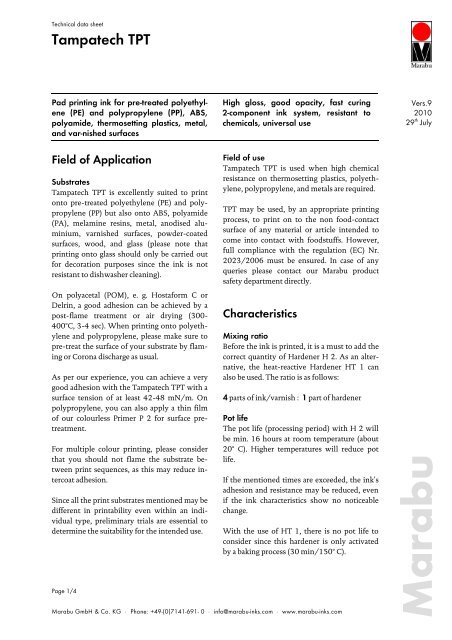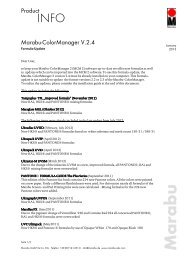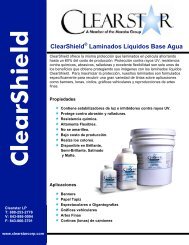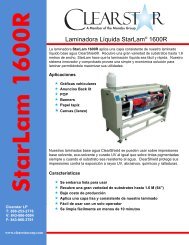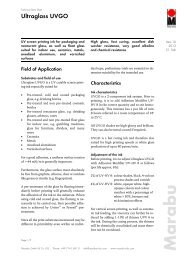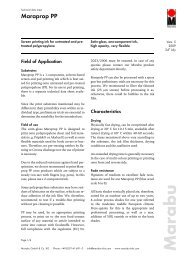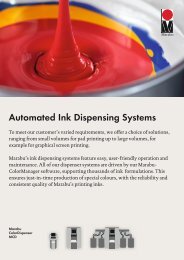Tampatech TPT M a ra b u - Marabu North America
Tampatech TPT M a ra b u - Marabu North America
Tampatech TPT M a ra b u - Marabu North America
You also want an ePaper? Increase the reach of your titles
YUMPU automatically turns print PDFs into web optimized ePapers that Google loves.
Technical data sheet<br />
<strong>Tampatech</strong> <strong>TPT</strong><br />
Pad printing ink for pre-treated polyethylene<br />
(PE) and polypropylene (PP), ABS,<br />
polyamide, thermosetting plastics, metal,<br />
and var-nished surfaces<br />
Field of Application<br />
Subst<strong>ra</strong>tes<br />
<strong>Tampatech</strong> <strong>TPT</strong> is excellently suited to print<br />
onto pre-treated polyethylene (PE) and polypropylene<br />
(PP) but also onto ABS, polyamide<br />
(PA), melamine resins, metal, anodised aluminium,<br />
varnished surfaces, powder-coated<br />
surfaces, wood, and glass (please note that<br />
printing onto glass should only be carried out<br />
for deco<strong>ra</strong>tion purposes since the ink is not<br />
resistant to dishwasher cleaning).<br />
On polyacetal (POM), e. g. Hostaform C or<br />
Delrin, a good adhesion can be achieved by a<br />
post-flame treatment or air drying (300-<br />
400°C, 3-4 sec). When printing onto polyethylene<br />
and polypropylene, please make sure to<br />
pre-treat the surface of your subst<strong>ra</strong>te by flaming<br />
or Corona discharge as usual.<br />
As per our experience, you can achieve a very<br />
good adhesion with the <strong>Tampatech</strong> <strong>TPT</strong> with a<br />
surface tension of at least 42-48 mN/m. On<br />
polypropylene, you can also apply a thin film<br />
of our colourless Primer P 2 for surface pretreatment.<br />
For multiple colour printing, please consider<br />
that you should not flame the subst<strong>ra</strong>te between<br />
print sequences, as this may reduce intercoat<br />
adhesion.<br />
Since all the print subst<strong>ra</strong>tes mentioned may be<br />
different in printability even within an individual<br />
type, preliminary trials are essential to<br />
determine the suitability for the intended use.<br />
Page 1/4<br />
High gloss, good opacity, fast curing<br />
2-component ink system, resistant to<br />
chemicals, universal use<br />
Field of use<br />
<strong>Tampatech</strong> <strong>TPT</strong> is used when high chemical<br />
resistance on thermosetting plastics, polyethylene,<br />
polypropylene, and metals are required.<br />
<strong>TPT</strong> may be used, by an appropriate printing<br />
process, to print on to the non food-contact<br />
surface of any material or article intended to<br />
come into contact with foodstuffs. However,<br />
full compliance with the regulation (EC) Nr.<br />
2023/2006 must be ensured. In case of any<br />
queries please contact our Ma<strong>ra</strong>bu product<br />
safety department directly.<br />
Cha<strong>ra</strong>cteristics<br />
Mixing <strong>ra</strong>tio<br />
Before the ink is printed, it is a must to add the<br />
correct quantity of Hardener H 2. As an alternative,<br />
the heat-reactive Hardener HT 1 can<br />
also be used. The <strong>ra</strong>tio is as follows:<br />
4 parts of ink/varnish : 1 part of hardener<br />
Pot life<br />
The pot life (processing period) with H 2 will<br />
be min. 16 hours at room tempe<strong>ra</strong>ture (about<br />
20° C). Higher tempe<strong>ra</strong>tures will reduce pot<br />
life.<br />
If the mentioned times are exceeded, the ink's<br />
adhesion and resistance may be reduced, even<br />
if the ink cha<strong>ra</strong>cteristics show no noticeable<br />
change.<br />
With the use of HT 1, there is no pot life to<br />
consider since this hardener is only activated<br />
by a baking process (30 min/150° C).<br />
Ma<strong>ra</strong>bu GmbH & Co. KG ⋅ Phone: +49-(0)7141-691- 0 ⋅ info@ma<strong>ra</strong>bu-inks.com ⋅ www.ma<strong>ra</strong>bu-inks.com Ma<strong>ra</strong>bu<br />
Vers.9<br />
2010<br />
29 th July
Technical data sheet<br />
<strong>Tampatech</strong> <strong>TPT</strong><br />
Drying<br />
Pa<strong>ra</strong>llel to physical drying (i. e. the evapo<strong>ra</strong>tion<br />
of the solvents used), the actual hardening of<br />
the ink film is caused by the chemical crosslinking<br />
reaction between ink and hardener.<br />
The following standard values concerning progressive<br />
cross-linking (hardening) of the ink<br />
film can be assumed:<br />
Drying times H 2 HT 1<br />
touch-dry 20 °C 1-2 min 2 min<br />
stackable 60 °C 30 min --<br />
final hardness 20 °C 5-7 days --<br />
final hardness 150°C 30 min 30 min<br />
pot life 20 °C min. 16 h 6 months<br />
Chemical cross-linking can be accele<strong>ra</strong>ted by<br />
higher tempe<strong>ra</strong>tures. The times mentioned<br />
vary according to subst<strong>ra</strong>te, depth of cliché,<br />
drying conditions, and the auxiliaries used.<br />
For fast printing sequences, we recommend<br />
forced air drying (about 200° C for 2-3 sec) of<br />
the surface after each colour.<br />
For multiple colour printing, we point out that<br />
the previous printed ink film should not be<br />
entirely cured before the consecutive ink film<br />
is printed on top of it. By drying at room tempe<strong>ra</strong>ture,<br />
the consecutive print should be carried<br />
out within 12 hours after the previous<br />
print.<br />
The processing and curing tempe<strong>ra</strong>ture should<br />
not be lower than 15° C as irreversible damage<br />
can occur. Also avoid high humidity for seve<strong>ra</strong>l<br />
hours after printing as the hardener is sensitive<br />
to humidity.<br />
Fade resistance<br />
Only pigments of high fade resistance are used<br />
in the <strong>Tampatech</strong> <strong>TPT</strong> <strong>ra</strong>nge. Please note, however,<br />
that <strong>TPT</strong> is not suited for outdoor applications<br />
with direct sun ir<strong>ra</strong>diation or humidity<br />
contact as the epoxy resin tends to chalk and as<br />
a consequence, the shades will change their<br />
original colour soon.<br />
Page 2/4<br />
The pigments used are resistant to solvents and<br />
plasticizers.<br />
Stress resistance<br />
After proper and thorough drying, the ink film<br />
exhibits outstanding adhesion as well as rub,<br />
sc<strong>ra</strong>tch, and block resistance and is resistant to<br />
a large number of chemical products, oils,<br />
greases, and solvents. However, on glass no<br />
resistance to dishwashers can be achieved. In<br />
this case, we recommend our Glass Ink GL.<br />
Clichés<br />
All commercially available clichés made of<br />
photopolymer material, thin steel, and chemically<br />
hardened steel (10 mm) can be used. We<br />
recommend a cliché depth of 20-28 µm.<br />
Printing pads<br />
As per our experience, all common printing<br />
pads consisting of materials cross-linked by<br />
condensation or addition can be used.<br />
Printing machines<br />
<strong>Tampatech</strong> <strong>TPT</strong> is suitable for closed ink cup<br />
systems, as well as for open ink wells. Depending<br />
on type and usage of the machine, it is to<br />
accordingly adjust type and amount of the<br />
thinner used.<br />
Range<br />
Basic shades<br />
Refer to colour chart ‘System Tampacolor’<br />
<strong>TPT</strong> 920 Lemon<br />
<strong>TPT</strong> 950 Violet*<br />
<strong>TPT</strong> 922 Light Yellow * <strong>TPT</strong> 952 Ult<strong>ra</strong>marine Bl.*<br />
<strong>TPT</strong> 924 Medium Yell. <strong>TPT</strong> 954 Medium Blue<br />
<strong>TPT</strong> 926 O<strong>ra</strong>nge<br />
<strong>TPT</strong> 956 Brilliant Blue*<br />
<strong>TPT</strong> 930 Vermilion * <strong>TPT</strong> 960 Blue Green<br />
<strong>TPT</strong> 932 Scarlet Red <strong>TPT</strong> 962 G<strong>ra</strong>ss Green *<br />
<strong>TPT</strong> 934 Carmine Red <strong>TPT</strong> 970 White<br />
<strong>TPT</strong> 936 Magenta* <strong>TPT</strong> 980 Black<br />
<strong>TPT</strong> 940 Brown<br />
(*semi-t<strong>ra</strong>nsparent/t<strong>ra</strong>nsparent)<br />
Ma<strong>ra</strong>bu GmbH & Co.KG ⋅ Phone: +49-(0)7141-691- 0 ⋅ info@ma<strong>ra</strong>bu-inks.com ⋅ www.ma<strong>ra</strong>bu-inks.com<br />
Ma<strong>ra</strong>bu
Technical data sheet<br />
<strong>Tampatech</strong> <strong>TPT</strong><br />
High-opaque colour shades<br />
<strong>TPT</strong> 122<br />
<strong>TPT</strong> 130<br />
<strong>TPT</strong> 152<br />
<strong>TPT</strong> 162<br />
Page 3/4<br />
Light Yellow<br />
Vermilion<br />
Ult<strong>ra</strong>marine Blue<br />
G<strong>ra</strong>ss Green<br />
All shades are intermixable. To maintain the<br />
special cha<strong>ra</strong>cteristics of this outstanding ink<br />
<strong>ra</strong>nge, <strong>TPT</strong> should not be mixed with other ink<br />
types.<br />
The basic shades according to System Tampacolor<br />
as well as the high-opaque shades are<br />
all included in our Ma<strong>ra</strong>bu-ColorFormulator<br />
building the calculation basis for individual<br />
colour matching formulas. The basic shades are<br />
further the basis for colour matches according<br />
to the common Pantone®, HKS®, RAL®, and<br />
Ma<strong>ra</strong>bu System 21 colour reference systems.<br />
All formulas are stored in the Ma<strong>ra</strong>bu-Color<br />
Manager 2 (MCM 2) software.<br />
The high-opaque formulas are additionally<br />
available in MCM 2 marked with + + behind<br />
the reference name. These formulas have been<br />
developed by using the System Tampacolor<br />
formulas for basic and high-opaque shades,<br />
excluding the semi-t<strong>ra</strong>nsparent, resp. t<strong>ra</strong>nsparent<br />
shades.<br />
Press-ready gold and silver shades<br />
<strong>TPT</strong> 191<br />
<strong>TPT</strong> 192<br />
<strong>TPT</strong> 193<br />
Silver<br />
Rich Pale Gold<br />
Rich Gold<br />
Clears<br />
<strong>TPT</strong> 910 Overprint Varnish, can also be used as bronze<br />
binder<br />
Bronzes<br />
(to be mixed with Overprint Varnish <strong>TPT</strong> 910)<br />
S 181 Aluminium<br />
S 182 Rich Pale Gold<br />
S 183 Rich Gold<br />
S 184 Pale Gold<br />
S 186 Copper<br />
S 190 Aluminium, rub-resistant<br />
Due to their chemical structure, Pale Gold<br />
S 184 and Copper S 186 have a reduced processing<br />
time. Please gene<strong>ra</strong>lly prepare fresh mixtures<br />
only as they cannot be stored and must be<br />
processed within 4 h.<br />
The pigments used in the above mentioned<br />
standard shades, based on their chemical structure,<br />
correspond to the EEC regulations EN<br />
71/part 3, safety of toys - mig<strong>ra</strong>tion of specific<br />
elements. All colours are suited for printing<br />
onto toys.<br />
Auxiliaries<br />
Hardener: H 2, fast hardener<br />
HT 1, heat-reactive<br />
Mixing <strong>ra</strong>tio: 4 p. ink : 1 p. hardener<br />
Thinner: TPV<br />
TPV 2, fast thinner<br />
TPV 3, slow thinner<br />
Retarder: SV 1<br />
VP, Retarder Paste<br />
Matting Powder: MP<br />
Antistatic Paste: AP<br />
Opaquing Paste: OP 170<br />
Primer: P 2, for polypropylene<br />
Cleaner: UR 4<br />
Printing Modifier: ES<br />
The hardener should be added to the ink briefly<br />
before printing in the correct <strong>ra</strong>tio as mentioned<br />
before.<br />
To adjust printing viscosity, it is gene<strong>ra</strong>lly sufficient<br />
to add 10-15% of Thinner TPV to the<br />
ink. Thinner TPV 2 can be used for fast printing,<br />
TPV 3 for slow printing requirements.<br />
By adding Matting Powder MP, the glossy effect<br />
of the ink is reduced to a silky or semi-matt<br />
finish. The addition of a low percentage of MP<br />
(in the case of 970 White, max. 2%) will not<br />
influence significantly the resistances of the<br />
ink but reduce its opacity.<br />
Ma<strong>ra</strong>bu GmbH & Co.KG ⋅ Phone: +49-(0)7141-691- 0 ⋅ info@ma<strong>ra</strong>bu-inks.com ⋅ www.ma<strong>ra</strong>bu-inks.com<br />
Ma<strong>ra</strong>bu
Technical data sheet<br />
<strong>Tampatech</strong> <strong>TPT</strong><br />
For the printing of very fine motives, Retarder<br />
SV 1 or Retarder Paste VP may be added to the<br />
ink. An excessive addition may result in ink<br />
t<strong>ra</strong>nsfer problems.<br />
Attention<br />
For an ink mixture containing retarder, only<br />
thinner should be used for additional thinning<br />
during the print run.<br />
By adding Opaquing Paste 170, the opacity of<br />
colour shades can significantly be increased<br />
without influencing the chemical and dry ab<strong>ra</strong>sion<br />
resistance conside<strong>ra</strong>bly. Maximum quantity<br />
to be added is 15%. OP 170 is not suitable<br />
for using it with white shades.<br />
Printing Modifier ES contains silicone. It can be<br />
used to rectify flow problems on critical subst<strong>ra</strong>tes<br />
by adding up to 1% by weight to the ink.<br />
If an excessive amount of printing modifier is<br />
added, flow problems are increased and adhesion<br />
may be reduced, especially when overprinting.<br />
Cleaning<br />
To clean ink containers, clichés, and tools,<br />
please use our Cleaner UR 4.<br />
Recommendation<br />
The ink should be stirred well before printing.<br />
To protect the ink in opened containers against<br />
excessive drying, it can be carefully covered<br />
with a layer of thinner which can then be later<br />
stirred into the ink prior to printing.<br />
Page 4/4<br />
Labelling<br />
For our ink type <strong>Tampatech</strong> <strong>TPT</strong> and its additives<br />
and auxiliaries, there are current Material<br />
Safety Data Sheets according to EC-regulation<br />
1907/2006 informing in detail about all relevant<br />
safety data including labelling according to<br />
the present EEC regulations as to health and<br />
safety labelling requirements. Such data may<br />
also be derived from the respective label.<br />
The ink has a flash point > 50° C<br />
(ASTM D 6450 method).<br />
Note<br />
Please refer to the information in our technical<br />
data sheets of pad printing inks. Our technical<br />
advice whether spoken, written, or through<br />
test trials corresponds to our current knowledge<br />
to inform about our products and their<br />
use. This is not meant as an assu<strong>ra</strong>nce for certain<br />
properties of the products nor their suitability<br />
for each application.<br />
You are, therefore, obliged to conduct your<br />
own tests with our supplied products to confirm<br />
their suitability for the desired process or<br />
purpose. The selection and testing of the ink<br />
for a concrete application are exclusively your<br />
responsibility.<br />
Should, however, any liability claims arise,<br />
they shall be limited to the value of the goods<br />
delivered by us and utilised by you with respect<br />
to any and all damages not caused intentionally<br />
or by gross negligence.<br />
Ma<strong>ra</strong>bu GmbH & Co.KG ⋅ Phone: +49-(0)7141-691- 0 ⋅ info@ma<strong>ra</strong>bu-inks.com ⋅ www.ma<strong>ra</strong>bu-inks.com<br />
Ma<strong>ra</strong>bu


